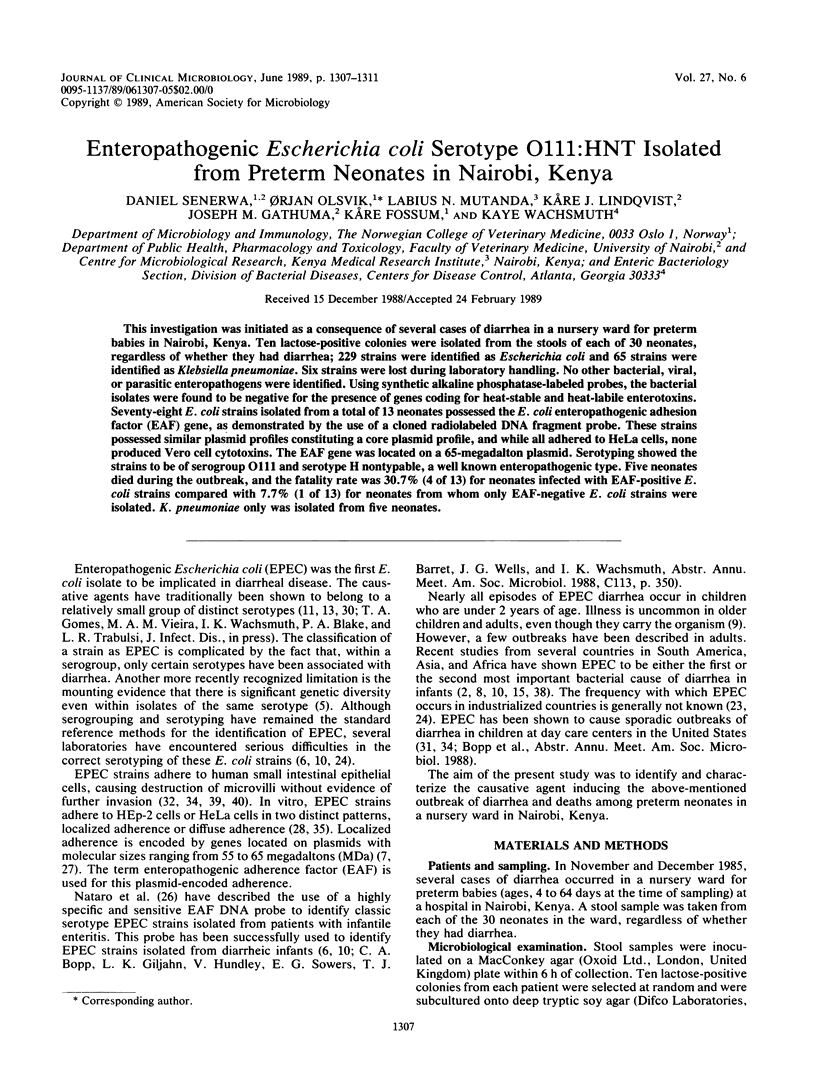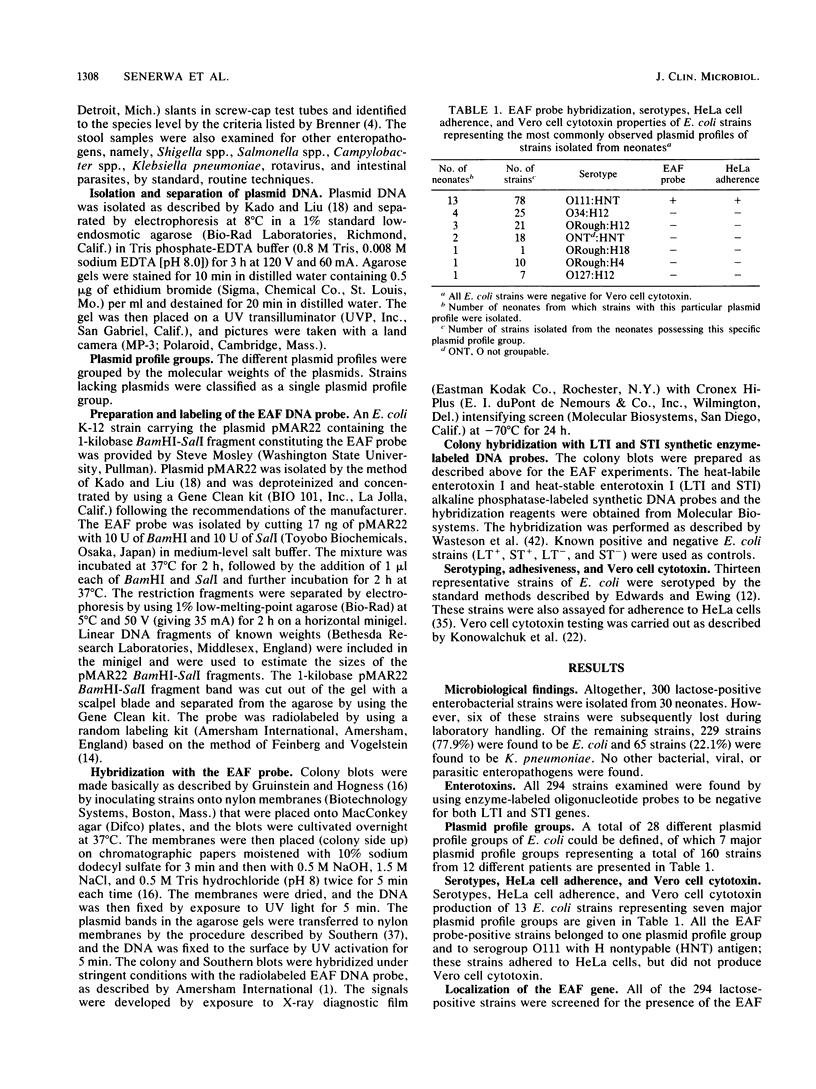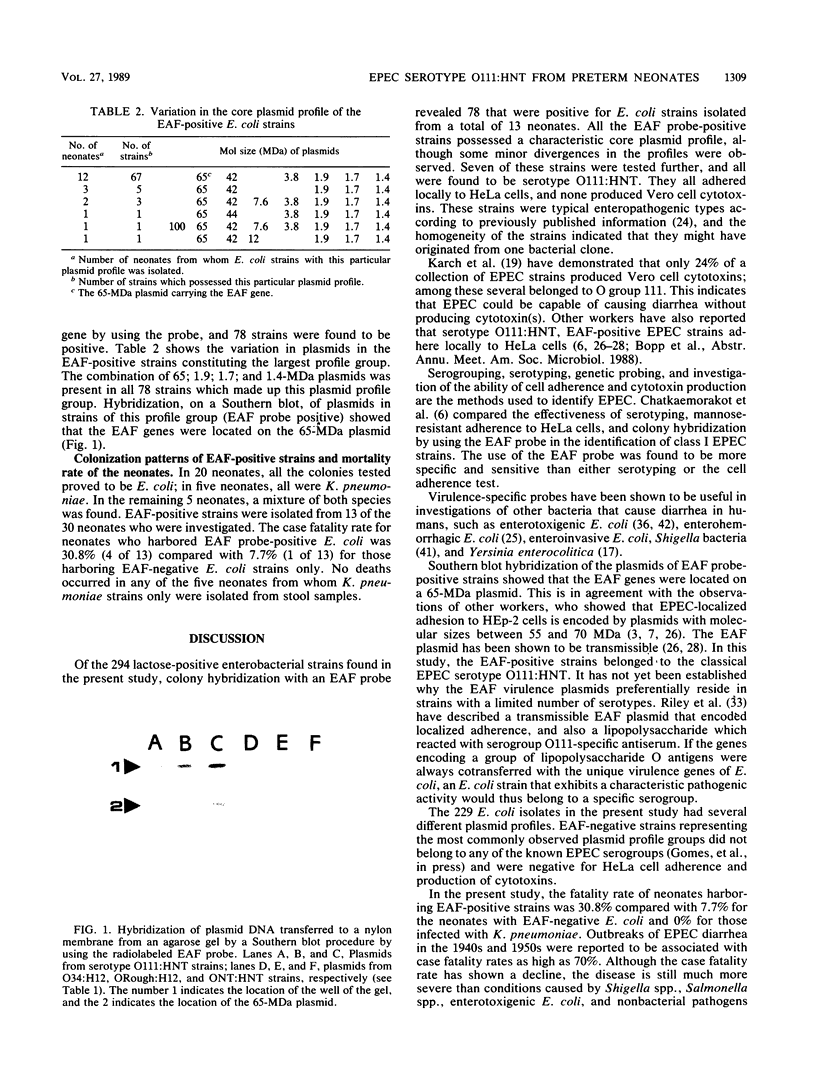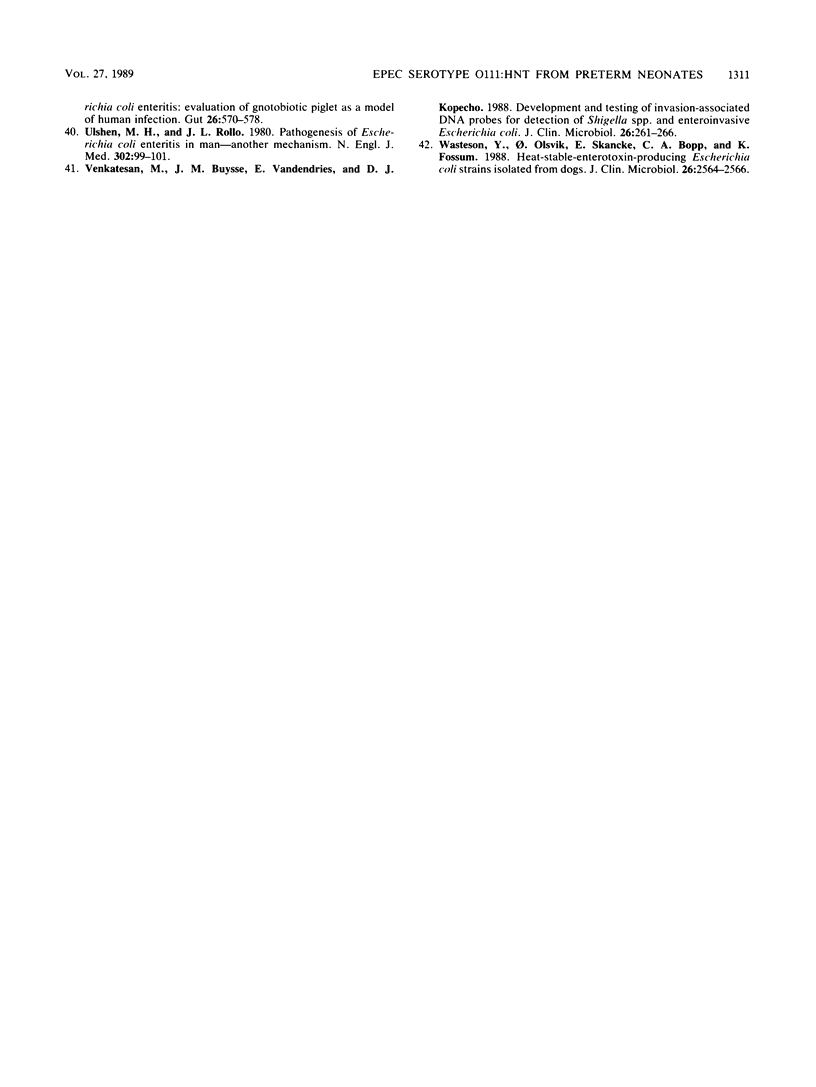Abstract
This investigation was initiated as a consequence of several cases of diarrhea in a nursery ward for preterm babies in Nairobi, Kenya. Ten lactose-positive colonies were isolated from the stools of each of 30 neonates, regardless of whether they had diarrhea; 229 strains were identified as Escherichia coli and 65 strains were identified as Klebsiella pneumoniae. Six strains were lost during laboratory handling. No other bacterial, viral, or parasitic enteropathogens were identified. Using synthetic alkaline phosphatase-labeled probes, the bacterial isolates were found to be negative for the presence of genes coding for heat-stable and heat-labile enterotoxins. Seventy-eight E. coli strains isolated from a total of 13 neonates possessed the E. coli enteropathogenic adhesion factor (EAF) gene, as demonstrated by the use of a cloned radiolabeled DNA fragment probe. These strains possessed similar plasmid profiles constituting a core plasmid profile, and while all adhered to HeLa cells, none produced Vero cell cytotoxins. The EAF gene was located on a 65-megadalton plasmid. Serotyping showed the strains to be of serogroup O111 and serotype H nontypable, a well known enteropathogenic type. Five neonates died during the outbreak, and the fatality rate was 30.7% (4 of 13) for neonates infected with EAF-positive E. coli strains compared with 7.7% (1 of 13) for neonates from whom only EAF-negative E. coli strains were isolated. K. pneumoniae only was isolated from five neonates.
Full text
PDF




Images in this article
Selected References
These references are in PubMed. This may not be the complete list of references from this article.
- Antai S. P., Anozie S. O. Incidence of infantile diarrhoea due to enteropathogenic Escherichia coli in Port Harcourt metropolis. J Appl Bacteriol. 1987 Mar;62(3):227–229. doi: 10.1111/j.1365-2672.1987.tb02403.x. [DOI] [PubMed] [Google Scholar]
- Baldini M. M., Kaper J. B., Levine M. M., Candy D. C., Moon H. W. Plasmid-mediated adhesion in enteropathogenic Escherichia coli. J Pediatr Gastroenterol Nutr. 1983;2(3):534–538. doi: 10.1097/00005176-198302030-00023. [DOI] [PubMed] [Google Scholar]
- Caugant D. A., Levin B. R., Orskov I., Orskov F., Svanborg Eden C., Selander R. K. Genetic diversity in relation to serotype in Escherichia coli. Infect Immun. 1985 Aug;49(2):407–413. doi: 10.1128/iai.49.2.407-413.1985. [DOI] [PMC free article] [PubMed] [Google Scholar]
- Chatkaeomorakot A., Echeverria P., Taylor D. N., Bettelheim K. A., Blacklow N. R., Sethabutr O., Seriwatana J., Kaper J. HeLa cell-adherent Escherichia coli in children with diarrhea in Thailand. J Infect Dis. 1987 Oct;156(4):669–672. doi: 10.1093/infdis/156.4.669. [DOI] [PubMed] [Google Scholar]
- Cravioto A., Reyes R. E., Ortega R., Fernández G., Hernández R., López D. Prospective study of diarrhoeal disease in a cohort of rural Mexican children: incidence and isolated pathogens during the first two years of life. Epidemiol Infect. 1988 Aug;101(1):123–134. doi: 10.1017/s0950268800029289. [DOI] [PMC free article] [PubMed] [Google Scholar]
- DuPont H. L., Formal S. B., Hornick R. B., Snyder M. J., Libonati J. P., Sheahan D. G., LaBrec E. H., Kalas J. P. Pathogenesis of Escherichia coli diarrhea. N Engl J Med. 1971 Jul 1;285(1):1–9. doi: 10.1056/NEJM197107012850101. [DOI] [PubMed] [Google Scholar]
- Echeverria P., Taylor D. N., Bettelheim K. A., Chatkaeomorakot A., Changchawalit S., Thongcharoen A., Leksomboon U. HeLa cell-adherent enteropathogenic Escherichia coli in children under 1 year of age in Thailand. J Clin Microbiol. 1987 Aug;25(8):1472–1475. doi: 10.1128/jcm.25.8.1472-1475.1987. [DOI] [PMC free article] [PubMed] [Google Scholar]
- Edelman R., Levine M. M. From the National Institute of Allergy and Infectious Diseases. Summary of a workshop on enteropathogenic Escherichia coli. J Infect Dis. 1983 Jun;147(6):1108–1118. doi: 10.1093/infdis/147.6.1108. [DOI] [PubMed] [Google Scholar]
- Feinberg A. P., Vogelstein B. A technique for radiolabeling DNA restriction endonuclease fragments to high specific activity. Anal Biochem. 1983 Jul 1;132(1):6–13. doi: 10.1016/0003-2697(83)90418-9. [DOI] [PubMed] [Google Scholar]
- Freiman I., Hartman E., Kassel H., Robins-Browne R. M., Schoub B. D., Koornhof H. J., Lecatsas G., Prozesky O. W. A microbiological study of gastro-enteritis in Black infants. S Afr Med J. 1977 Aug 6;52(7):261–265. [PubMed] [Google Scholar]
- Grunstein M., Hogness D. S. Colony hybridization: a method for the isolation of cloned DNAs that contain a specific gene. Proc Natl Acad Sci U S A. 1975 Oct;72(10):3961–3965. doi: 10.1073/pnas.72.10.3961. [DOI] [PMC free article] [PubMed] [Google Scholar]
- Hill W. E., Payne W. L., Aulisio C. C. Detection and enumeration of virulent Yersinia enterocolitica in food by DNA colony hybridization. Appl Environ Microbiol. 1983 Sep;46(3):636–641. doi: 10.1128/aem.46.3.636-641.1983. [DOI] [PMC free article] [PubMed] [Google Scholar]
- KAUFFMANN F., DUPONT A. Escherichia strains from infantile epidemic gastro enteritis. Acta Pathol Microbiol Scand. 1950;27(4):552–564. doi: 10.1111/j.1699-0463.1950.tb04927.x. [DOI] [PubMed] [Google Scholar]
- Kado C. I., Liu S. T. Rapid procedure for detection and isolation of large and small plasmids. J Bacteriol. 1981 Mar;145(3):1365–1373. doi: 10.1128/jb.145.3.1365-1373.1981. [DOI] [PMC free article] [PubMed] [Google Scholar]
- Karch H., Heesemann J., Laufs R. Phage-associated cytotoxin production by and enteroadhesiveness of enteropathogenic Escherichia coli isolated from infants with diarrhea in West Germany. J Infect Dis. 1987 Apr;155(4):707–715. doi: 10.1093/infdis/155.4.707. [DOI] [PubMed] [Google Scholar]
- Konforti N., Lev B., Hanner N. Sensitivity of strains of enteropathogenic Escherichia coli to tobramycin and other antibiotics. Med Microbiol Immunol. 1977 Dec 27;163(4):269–276. doi: 10.1007/BF02125511. [DOI] [PubMed] [Google Scholar]
- Konowalchuk J., Speirs J. I., Stavric S. Vero response to a cytotoxin of Escherichia coli. Infect Immun. 1977 Dec;18(3):775–779. doi: 10.1128/iai.18.3.775-779.1977. [DOI] [PMC free article] [PubMed] [Google Scholar]
- Levine M. M., Edelman R. Enteropathogenic Escherichia coli of classic serotypes associated with infant diarrhea: epidemiology and pathogenesis. Epidemiol Rev. 1984;6:31–51. doi: 10.1093/oxfordjournals.epirev.a036274. [DOI] [PubMed] [Google Scholar]
- Levine M. M. Escherichia coli that cause diarrhea: enterotoxigenic, enteropathogenic, enteroinvasive, enterohemorrhagic, and enteroadherent. J Infect Dis. 1987 Mar;155(3):377–389. doi: 10.1093/infdis/155.3.377. [DOI] [PubMed] [Google Scholar]
- Levine M. M., Xu J. G., Kaper J. B., Lior H., Prado V., Tall B., Nataro J., Karch H., Wachsmuth K. A DNA probe to identify enterohemorrhagic Escherichia coli of O157:H7 and other serotypes that cause hemorrhagic colitis and hemolytic uremic syndrome. J Infect Dis. 1987 Jul;156(1):175–182. doi: 10.1093/infdis/156.1.175. [DOI] [PubMed] [Google Scholar]
- Nataro J. P., Baldini M. M., Kaper J. B., Black R. E., Bravo N., Levine M. M. Detection of an adherence factor of enteropathogenic Escherichia coli with a DNA probe. J Infect Dis. 1985 Sep;152(3):560–565. doi: 10.1093/infdis/152.3.560. [DOI] [PubMed] [Google Scholar]
- Nataro J. P., Maher K. O., Mackie P., Kaper J. B. Characterization of plasmids encoding the adherence factor of enteropathogenic Escherichia coli. Infect Immun. 1987 Oct;55(10):2370–2377. doi: 10.1128/iai.55.10.2370-2377.1987. [DOI] [PMC free article] [PubMed] [Google Scholar]
- Nataro J. P., Scaletsky I. C., Kaper J. B., Levine M. M., Trabulsi L. R. Plasmid-mediated factors conferring diffuse and localized adherence of enteropathogenic Escherichia coli. Infect Immun. 1985 May;48(2):378–383. doi: 10.1128/iai.48.2.378-383.1985. [DOI] [PMC free article] [PubMed] [Google Scholar]
- Nicoletti M., Superti F., Conti C., Calconi A., Zagaglia C. Virulence factors of lactose-negative Escherichia coli strains isolated from children with diarrhea in Somalia. J Clin Microbiol. 1988 Mar;26(3):524–529. doi: 10.1128/jcm.26.3.524-529.1988. [DOI] [PMC free article] [PubMed] [Google Scholar]
- Paulozzi L. J., Johnson K. E., Kamahele L. M., Clausen C. R., Riley L. W., Helgerson S. D. Diarrhea associated with adherent enteropathogenic Escherichia coli in an infant and toddler center, Seattle, Washington. Pediatrics. 1986 Mar;77(3):296–300. [PubMed] [Google Scholar]
- Polotsky Y. E., Dragunskaya E. M., Seliverstova V. G., Avdeeva T. A., Chakhutinskaya M. G., Kétyi I., Vertényl A., Ralovich B., Emödy L., Málovics I. Pathogenic effect of enterotoxigenic Escherichia coli and Escherichia coli causing infantile diarrhoea. Acta Microbiol Acad Sci Hung. 1977;24(3):221–236. [PubMed] [Google Scholar]
- Riley L. W., Junio L. N., Libaek L. B., Schoolnik G. K. Plasmid-encoded expression of lipopolysaccharide O-antigenic polysaccharide in enteropathogenic Escherichia coli. Infect Immun. 1987 Sep;55(9):2052–2056. doi: 10.1128/iai.55.9.2052-2056.1987. [DOI] [PMC free article] [PubMed] [Google Scholar]
- Rothbaum R., McAdams A. J., Giannella R., Partin J. C. A clinicopathologic study of enterocyte-adherent Escherichia coli: a cause of protracted diarrhea in infants. Gastroenterology. 1982 Aug;83(2):441–454. [PubMed] [Google Scholar]
- Scaletsky I. C., Silva M. L., Trabulsi L. R. Distinctive patterns of adherence of enteropathogenic Escherichia coli to HeLa cells. Infect Immun. 1984 Aug;45(2):534–536. doi: 10.1128/iai.45.2.534-536.1984. [DOI] [PMC free article] [PubMed] [Google Scholar]
- Seriwatana J., Echeverria P., Taylor D. N., Sakuldaipeara T., Changchawalit S., Chivoratanond O. Identification of enterotoxigenic Escherichia coli with synthetic alkaline phosphatase-conjugated oligonucleotide DNA probes. J Clin Microbiol. 1987 Aug;25(8):1438–1441. doi: 10.1128/jcm.25.8.1438-1441.1987. [DOI] [PMC free article] [PubMed] [Google Scholar]
- Southern E. M. Detection of specific sequences among DNA fragments separated by gel electrophoresis. J Mol Biol. 1975 Nov 5;98(3):503–517. doi: 10.1016/s0022-2836(75)80083-0. [DOI] [PubMed] [Google Scholar]
- Toledo M. R., Alvariza M. do C., Murahovschi J., Ramos S. R., Trabulsi L. R. Enteropathogenic Escherichia coli serotypes and endemic diarrhea in infants. Infect Immun. 1983 Feb;39(2):586–589. doi: 10.1128/iai.39.2.586-589.1983. [DOI] [PMC free article] [PubMed] [Google Scholar]
- Tzipori S., Robins-Browne R. M., Gonis G., Hayes J., Withers M., McCartney E. Enteropathogenic Escherichia coli enteritis: evaluation of the gnotobiotic piglet as a model of human infection. Gut. 1985 Jun;26(6):570–578. doi: 10.1136/gut.26.6.570. [DOI] [PMC free article] [PubMed] [Google Scholar]
- Ulshen M. H., Rollo J. L. Pathogenesis of escherichia coli gastroenteritis in man--another mechanism. N Engl J Med. 1980 Jan 10;302(2):99–101. doi: 10.1056/NEJM198001103020207. [DOI] [PubMed] [Google Scholar]
- Venkatesan M., Buysse J. M., Vandendries E., Kopecko D. J. Development and testing of invasion-associated DNA probes for detection of Shigella spp. and enteroinvasive Escherichia coli. J Clin Microbiol. 1988 Feb;26(2):261–266. doi: 10.1128/jcm.26.2.261-266.1988. [DOI] [PMC free article] [PubMed] [Google Scholar]
- Wasteson Y., Olsvik O., Skancke E., Bopp C. A., Fossum K. Heat-stable-enterotoxin-producing Escherichia coli strains isolated from dogs. J Clin Microbiol. 1988 Dec;26(12):2564–2566. doi: 10.1128/jcm.26.12.2564-2566.1988. [DOI] [PMC free article] [PubMed] [Google Scholar]



